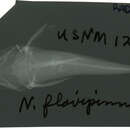fi
nimet breadcrumb-navigoinnissa


Yellowfin madtoms are capable of vision and hearing, but probably rely most heavily on touch and chemoreception. The barbels on the face are specialized for these senses, and are probably adaptations to a nocturnal and secretive lifestyle.
Perception Channels: visual ; tactile ; acoustic ; vibrations ; chemical
Noturus flavipinnis is listed as vulnerable on the IUCN Red list, and as threatened on the United States Endangered Species Act list.
US Federal List: threatened
CITES: no special status
IUCN Red List of Threatened Species: vulnerable
The hatching size of Noturus flavipinnis larvae is approximately 8 mm standard length. The development times for the species are unknown, but they probably depend upon temperatures of the water. After one summer's growth, the young reach lengths of approximately 50 mm. Both sexes become reproductively mature in the third summer of their lives, when they have reached a length of approximately 100 mm. They will live to be 3 to 4 years old, and will probably only spawn twice in their lifetime.
As Noturus flavipinnis is a federally listed species, some local businesses or industries may be impacted by conservation laws.
Yellowfin madtoms are not economically important.
Yellowfin madtoms are benthic secondary consumers. They feed on primary consumers and provide prey for larger carnivores. They may have some effects on the bottom substrate within their home pools, although these are not well known.
Feeding by Noturus flavipinnis takes place mainly at night. It may, however, sometimes feed during the day. Its diet consists mostly of aquatic insect larvae, but crayfish may also be eaten. This species may exhibit some preferences in diet, but it is also an opportunistic feeder. It is also known to be a benthic feeder.
Animal Foods: insects; aquatic crustaceans
Primary Diet: carnivore (Insectivore , Eats non-insect arthropods)
Noturus flavipinnis (yellowfin madtom) can be found only in the upper portion of the Tennessee River drainage, in the Powell River and Citico Creek in Tennessee, and in Copper Creek in Virginia. Before 1893, yellowfin madtom populations could also be found in North Fork Holston River in Virginia, Hines Creek in Tennessee, and Chickamauga Creek in Georgia.
Biogeographic Regions: nearctic (Native )
Noturus flavipinnis inhabits pools and backwaters of streams, where it can find cover beneath tree roots, sunken leaves, brush piles, or bedrock ledges. Individuals can be found in shallow pools less than one meter deep, and are usually not found further down than two meters in deeper pools. The streams where Noturus flavipinnis can be found are clean, with little siltation. Spawning habitat may be in the cleaner substrate of quicker currents than their usual habitat.
Range depth: 2 (high) m.
Habitat Regions: temperate ; freshwater
Aquatic Biomes: benthic ; rivers and streams
Noturus flavipinnis has a typical lifespan of 3-4 years; the maximum reported age is 4 years.
Range lifespan
Status: wild: 4 (high) years.
Typical lifespan
Status: wild: 3 to 4 years.
Typical lifespan
Status: captivity: 3 to 4 years.
Noturus flavipinnis is a small member of the catfish family (Ictaluridae), with a maximum standard length of 115 mm. The dorsal area and fins have a yellowish tinge. There are dark blotches beneath the dorsal fin origin, behind the dorsal fin, and at the adipose fin base. The caudal fin base has a crescent-shaped dark bar crossing it, and the dorsal fin has a dark medial stripe. The pectoral spine has well-developed anterior and posterior serrae. Caudal fin rays number 54 to 63, pelvic fin rays 8, sometimes 7. Anal fin rays number 14 to 16, and there are usually two internasal pores.
Similar species include Noturus baileyi (smoky madtom), but this species can be distinguished from yellowfin madtom by its nearly complete lack of dark pigmentation on the dorsal and caudal fins.
Range length: 115 (high) mm.
Other Physical Features: ectothermic ; heterothermic ; bilateral symmetry
Little is known about the interspecies relationships of yellowfin madtoms. Their specific predators are not known. They do, however exibit cryptic coloring and hiding behavior, which are common predator avoidance strategies.
Anti-predator Adaptations: cryptic
Noturus flavipinnis reproduces from late May to mid July. Females may be able to spawn twice per season, and as the male guards the nest, mating is probably polyandrous, with no pair bonds formed.
Mating System: polyandrous
Noturus flavipinnis spawns from late May to mid July. Females produce 121 to 278 eggs per season, probably in multiple spawning acts, since males appear to guard clutches of just 30 to approximately 100 eggs. Nest sites are in cavities beneath slabs of rock. Eggs take about 8 days to hatch, and the young are guarded by the male for approximately 2 weeks.
Breeding interval: Noturus flavipinnis males spawn once per season, but females may spawn twice per season.
Breeding season: Noturus flavipinnis spawn from late May to mid July.
Range number of offspring: 30 to 278.
Average number of offspring: 89.
Average gestation period: 8 days.
Average time to independence: 2 weeks.
Average age at sexual or reproductive maturity (female): 2 years.
Average age at sexual or reproductive maturity (male): 2 years.
Key Reproductive Features: iteroparous ; seasonal breeding ; gonochoric/gonochoristic/dioecious (sexes separate); sexual ; fertilization (External ); oviparous
Average number of offspring: 65.
Female yellowfin madtoms expend the majority of their reproductive effort in producing eggs. Males prepare nest sites by enlarging natural cavities beneath rock slabs, and then guard the eggs and young for approximately 2 weeks, driving away intruders and keeping the nest free of silt.
Parental Investment: male parental care ; pre-hatching/birth (Protecting: Male); pre-independence (Protecting: Male)